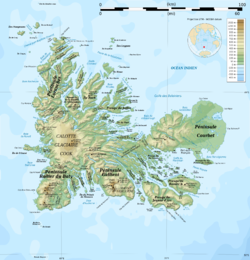Geography
The Cook Ice Cap reaches a maximum elevation of 1,049 metres (3,442 ft) in its central area. [2] It had a surface of approximately 500 km2 (190 sq mi) in 1963, having shrunk to about 400 km2 (150 sq mi) in recent times. [3]
Named after British explorer James Cook (1728–1779), on French navigational charts of the early 20th century this ice cap appears as "Richthofen Glacier" (Glacier Richthofen). [4]
Glaciers
About sixty glaciers flow from the inner ice cap in a roughly radial pattern. At the feet of the snout of these outlet glaciers there are often terminal moraines with dammed lakes of varying sizes. Further down the glacial meltwaters have formed numerous outwash plains at certain, mostly inland, locations. Of the glaciers originating in the Cook Ice Cap, only the Pasteur and Mariotte Glaciers have their termini in the Indian Ocean at the Anse des Glaçons in southwestern Kerguelen's deeply indented coastline. [3] [5]
The following are the main glaciers listed clockwise:
This page is based on this
Wikipedia article Text is available under the
CC BY-SA 4.0 license; additional terms may apply.
Images, videos and audio are available under their respective licenses.





